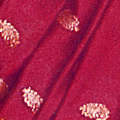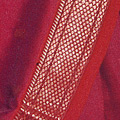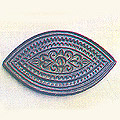Paithan (near Aurungabad) in Maharashtra is the home of the paithan sari, an extremely rich silk and zari sari. This traditional sari also represents a very old weaving tradition. An inscription in the Sun Temple at Mandsaur in Madhya Pradesh mentions paithani weavers. The Maratha Peshwas had a special love for this fabric. The paithani was extremely popular during Peshwa rule in Maharashtra, a time when it received sustained royal patronage. (At this time, the yardage was also used for stitched garments). There are records of a Peshwa king in the seventeenth century asking his Prime Minister Nana Phadnavis to send him paithani garments and, in the nineteenth century, of the Nizam of Hyderabad ordering it for his wife.
The paithani has always been a symbol of affluence and social prestige. Traditionally, social standing was determined by the width and richness of the embroidered pallu (end-piece). Paithanis were a must at traditional Maharashtrian weddings; the links, however, were more to do with displays of wealth than associations of ritual auspiciousness (like the Gujarat patola). The bride often wore a paithani shalu, a remarkably more ornate form of the already rich paithani sari.
-
Field: The traditional paithani has a coloured silk (sometimes cotton) field; ‘the field contains a fair amount of supplementary zari patterning’. The field is now commonly woven of pure silk; earlier, silk and metal (gold thread) end-panels (pallus) and borders were sometimes woven separately and attached to fabrics of pure cotton.
-
Borders: ‘The borders are created using the interlocked-weft technique, either with coloured silks or zari’. ‘A wide band of supplementary warp zari (in a mat pattern) is woven upon the coloured silk border. In borders woven with a zari ground, coloured silk patterns are added as a supplementary-weft “inlay” against the zari.…’
-
Endpiece: The end-piece has ‘fine silk warp threads…[and] the weft threads are only of zari, forming a “golden” ground upon which angular, brightly coloured silk designs are woven in the interlocked-weft technique, producing a tapestry effect.’

(Lynton & Singh, 1995: p. 150)
The saris are woven without a mechanical contrivance like a jacquard or jala; multiple spindles or tillis are used to produce the design. Over the years the traditional method of weaving these saris has remained unchanged – the use of wooden looms, operated dominantly by women, predominates.
Paithanis are found in rich, deep colours like blue, dark green, purple and magenta, with gold zari and silk embellishment. The distinctive feature of the paithani is the enamel-like quality of the silk patterns inlaid; each motif is outlined in complementary depth. This style of woven patterning is known as minakari.
A common design is a silk field brocaded with asharfis (circular gold, coin-like medallions), or gridded broadly with gold stripes, each check enclosing a brocaded motif. The field also has a showering of other small motifs like stars. The pallu is heavily ornamented. Traditional motifs include the asavali (vine and flowers), kalas pakli (a petal form), anarvel (pomegranate flower – Mughal influence), and the tota-maina (parrots – Mughal influence). One of the most complex designs is the bangdimor (Mughal influence): this has four peacocks arranged in a circle. The patterns are highly stylised and the frequency of the bird and flower motifs have led to the saris being named, colloquially, Ajanta Lotus or tota maina. (Tradition has it that the daughter-in-law of the Nizam of Hyderabad added motifs from the Ajanta caves to the design vocabulary of the paithani.) Although now the body and pallu are often in the same colour (as well as in gentle hues); traditional paithanis had the body of the sari and the pallu in contrasting (rich) colours.

The weavers have also adapted to market conditions by varying the amount of zari used, and the intricacy of the design woven. Earlier, the borders and pallus were made of gold mixed with copper to give it strength. Gold and copper were blended and spun into the fine zari. In more recent times the zari is made of silver drawn into a fine thread and washed with gold. The working out of a particular design varies in intricacy, necessitating variations in the quantity of material used and in the price range as well. For instance, the asavali design can be done in a fairly simple process or in a highly complex form. In its more ornate form, as many as 400 tillies (small paper shuttles around which individual shades of thread are wound) can be used to create a border and pallu. Often, to make the sari more affordable the silk is substituted with cotton. Many skilled workers have left Paithan and made their way to Yeola near Nasik in north-western Maharashtra. Here they have introduced some mechanisation and are experimenting with blended fabrics in order to make this sari more affordable.
Gallery
YOUR VIEWS
PRACTITIONERS: INDIA
Access 70,000+ practitioners in 2500+ crafts across India.
BIBLIOGRAPHY
10,000+ listings on arts, crafts, design, heritage, culture etc.
GLOSSARY
Rich and often unfamiliar vocabulary of crafts and textiles.
SHOP at India InCH
Needs to be written.






